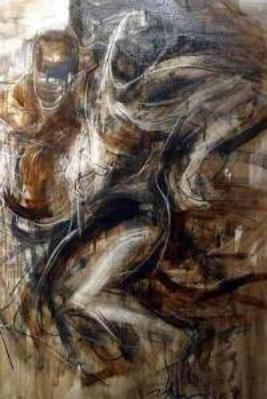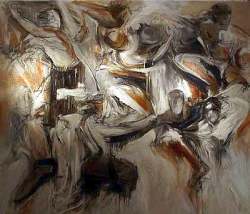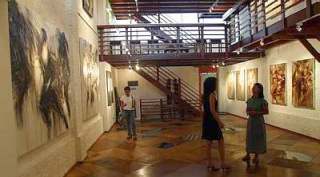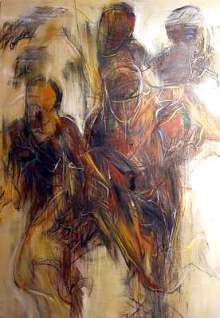The Star, 4 March 2006
The passion of an angry man
BENEATH the gentle and soft-spoken demeanour of highly acclaimed artist Yusof Ghani is a man of strong character with steely determination.
At 56, the affable man still has the energy and passion of a young man and is opinionated about social issues like famine, war, poverty, and injustice.
His anguish is reflected in his works of art.
“My anger has been with me for 30 years. It started when I was a fresh graduate,” said Yusof, who studied in the United States.
At that time, he was studying graphic design and was introduced to the fine arts course by his professor.
He discovered that fine arts was different as it was about expressing yourself rather than producing works in accordance to your client’s requirement as in graphic design.

This piece, entitled Victims 2006, under the Segerak III series was painted with charcoal and oil on linen.
“I was influenced by the American expressionism. You can paint just about anything, whether there is or isn’t any subject matter involved.
“I also developed a fondness for humanistic element,” said Yusof.
He added that perhaps his frequent travelling turned him into a social critic.
“In one part of the world, we have people who are obsessed with weight-loss, while elsewhere, people die of starvation due to poverty or famine!
“I came back from the United States an angry man because of these issues,” said Yusof.
When asked if he has mellowed over the years, he firmly answered, “No.”

Masterful command of strokes is what sets Yusof apart from the rest. This painting, called Fighter 2005, is one of them.
“I’m still an angry man.”
One could sense that in his latest composition, called Segerak III, currently exhibited at Wei-Ling Gallery in Brickfields.
In all the 23 pieces, figure sketches in black, white and brown tell personal stories, reflecting the good and evil in today’s society.
“As you can see, no vibrant colours are used. In a way, colour has become secondary in my work and spontaneity is what’s important.
“Compared to my past two series, Segerak I and II, form and speed here are my primary focus,” said Yusof, a lecturer of UiTM Shah Alam.
He said materials like bitumen, charcoal and chalk, were layered on various types of linen and polyester to give Segerak III a unique freshness.
“The idea for my Segerak series came as a reflection on the issue of one’s daily life-cycle such as people rushing to work and back home, which has become way too robotic.
“There is this humanistic element in Segerak, to show that things are moving whether we like it or not.”
The Pontian-born artist added that Segerak is a continuity of his famed Siri Tari series painted from 1984 to 1991.
He used fluid lines as metaphor to express the chaos in society due to inequality.
“I painted with only my emotions and was not too worried about anything else.”
He then proceeded to his Topeng series produced in 1992, which was inspired by the masks worn by Kenyan tribe in Sarawak during his trip there.
The masks are used as metaphor for our role in society.
“I paint everything from memory. It’s about spontaneity, as I never sketch.
“I usually stare at a blank canvas for days before having any ideas as to what stories to tell.”
During the recent soft opening, the gallery’s main exhibition area featured Segerak III works while the second exhibition level highlighted some striking samples of previous works.
The exhibition is on until March 8.



